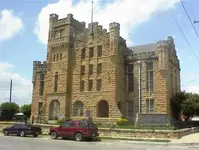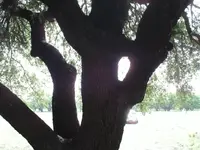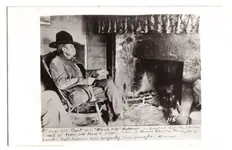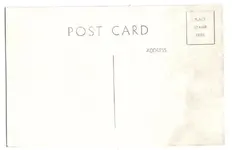Here is an interesting article about some former Guerrillas who visited Brownwood in central Texas that I first posted at my Yahoo group listed below.
***
I urge our members to read this account carefully as it documents
several visits to Brownwood by Frank & Jesse James and Cole Younger.
This story relates to Comanche County, Oklahoma and not to Brown
County, Texas' adjoining Comanche County.
~Jay~
****
http://www.rootsweb.com/~okcomanc/pioneers/deancsalyer.html
***
Comanche County Pioneers
Interview with Dean C. Salyer
Lawton, Comanche County Oklahoma
July 23, 1913 - October 31, 1973
(Dean was married to my father's sister, Ethel Burnett)
Sharon Burnett-Crawford
Jesse James's Two Million Dollar Treasure
Dean C. Salyer, of Lawton, first visited Oklahoma more than 25 yrs
ago with the goal of finding the lost treasure of Jesse James. He has
periodically sought the $180,000 he believes to be hidden in the
rocks not far from Cutthroat Gap, in far northwest corner of Comanche
County.
Salyer, a tree surgeon, a former cowboy, and a treasurer hunter is
another who came into personal contact with an aging member of the
outlaw band, but far away from the Wichita Mountains.
I haven't found anything, but I haven't given up looking, even
thought I've slowed down a mite. One thing I know, Jesse and Frank
James buried one hundred and eighty thousand dollars in those hills.
Make no mistake about that.
You might wonder how I came to know all this. It was all from an old
outlaw in Brownwood, Texas - that's where I'm from originally - who
was a good friend to Jesse and Frank. Even after Frank was acquitted
of his crimes, he used to come down to Brownwood just to talk over
old times with this man, whom I knew as Conley. I imagine they talked
over buried treasure, too, although Conley never admitted as much.
During the depression Salyer worked as a cook, carpenter, farmer,
cowboy, or in any other job he could find. During that time he met
the aged Conley. Conley and his family were hungry. Salyer asked no
questions and slipped Conley a ten dollar bill. Over the months a
great friendship developed. Salyer recalled with fond memories
visiting Conley for hours at a time, listening to him tell of his
strange past.
Conley spoke often of outlaws, but it was a long time before he said
just who the outlaws were. He was more of a lookout man for Jesse as
I gathered it. At first I didn't think to much of his story. But, you
know, he talked like he must have been there. And, too, he had a
cowhide map which he said was one of only three copies.
Salyer and Conley talked often of making a trip to the Wichita
Mountains to reclaim the treasure that Conley knew had been buried -
that is, if Frank hadn't recovered it himself, and Conley had his
reasons for believing that he had not.
Before the old man and I could make the trip, Conley died, but before
he died, he gave me his directions and let me look at the map. The
old outlaw told Salyer that the gold was hidden in a sealed cave. A
natural stone corral known to the outlaws as Horse Thief Corral, a
log cabin in Cutthroat Gap, and a Winchester rifle mounted in the
fork of a tree were the signs leading to the hidden cave.
It was years before Salyer moved from Brownwood to Oklahoma, and it
was several years more before he made his first trip to the Wichitas.
Finally in the 1950's, he enlisted the aid of J.B. "Burt" Holderbaum,
an old prospector left over from the gold rush days and together they
rediscovered the old stone corral in the shadow of Cutthroat Gap, a
valley into the mountains from the north that had earned its title
more than a century before in 1883 when Osages massacred their Kiowa
neighbors and placed their severed heads in brass buckets. Holderbaum
was one of the few living persons who knew the location of the rock
pen.
At first even Holderbaum had trouble locating the outlaw lair, but he
knew that it was on level ground at the bast of Mount Pinchot, the
highest peak in the Wichitas, although it does not appear to be. An
old trail ran past the corral, but the animals inside were hidden
from view, Holderbaum remembered. In one corner of the corral stood
the rotten stumps of two trees that had once served as gateposts.
Holderbaum recalled having served as gateposts. Holderbaum recalled
having been shown the corral in 1901. At that time a rock fortress
said to have been used by outlaws was still visible about two miles
north. Its breastwork was constructed from boulders stacked in a
large circle on top of a lone hill, which in 1901 had but one lone
cedar growing on it. It had been some time before that Holderbaum
found a rust eaten rifle hanging in an oak tree just west of the
makeshift fortress.
The cabin in Cutthroat Gap was a clue that I could never forget. A
bandit queen once lived in the cabin. She apparently purchased the
food and supplies for the outlaw bunch. Old Conley often mentioned
her, always with a smile.
At the summit of Mount Pinchot a long, black streak plunges twenty
feet down a bluff.
The black streak is a sign too. The gold is between the streak and
the hanging rifle, if Conley didn't err in his directions. My
partners and I searched continuously for six weeks during one spell.
We looked every day except Sundays but had no luck in finding
anything more than the corral, fortress, and ruins of the cabin. The
180,000 was part of a payroll robbery at Dodge City as I remember.
Every since early boyhood in Brownwood, Texas, Salyer had heard tales
of a prominent banker there who was believed to be the real Jesse
James but who went under the name Colonel Henry Ford. But there is no
record that Ford ever admitted such or even pretended to be James.
However, even today, old residents of Brownwood will swear that Ford
was indeed Jesse, for he had no other reason to keep a mysterious
trunk in his house under lock and key. Too, many residents believed
the legend because both Frank James and Cole Younger made trips to
Brownwood to see Ford, and Frank's sister, Susan, and brother-in-law,
Allan Parmer, lived nearby, just outside El Dorado.
Ford first appeared at Brownwood in 1870's, later served as its mayor
and then as president of the Coggin Brothers and Ford Bank. It is
possible that Ford was a member of Quantrill's guerrillas or even one
of the original outlaws who rode with Jesse. Whoever he was, Frank
and Cole had a lot to talk over with him after the turn of the
century.
Salyer regrets that he and Conley never made their trip to the
Wichitas before Conley died. But at that time it seemed impossible.
Occasionally Salyer still pokes around in the shadow of Cutthroat
Gap.
Frank James recovered some of the loot. Joe Hunter unearthed some of
the treasure that Frank had failed to find. The clues have been to
many to dismiss as legend, the brass bucket with the outlaw contract,
the silver watch, the graves, the gold bracelets, the copper sheet
with its secret code, and of course the maps, to old and perhaps to
cryptic for anyone to read now. Yet treasure seekers still dig in
lonely canyons, scan out of the way pinnacles and explore musty
smelling caves in quest of Jesse James's two million dollar treasure,
secreted in the Wichita Mountains at a time when those hills harbored
some of the deadliest outlaws of the west.
Frank himself is said to have once revealed that the treasure was
buried alongside the old Chisholm Trail between Fort Sill and the
Keechi Hills. It must still await some lucky finder, one who can
break its secret code and follow th long trail that Frank James rode
hard enough to wear out six horses.
Pioneers Home
Comanche County OKGenWeb
County Coordinator:
Margie Etter
Co-Coordinator
Sharon Burnett Crawford
This Page Last Updated Friday, 21-Nov-2003 13:33:37 MST
****
~Jay~
http://groups.yahoo.com/group/bloodybillandersonmystery - We have been studying the KGC since before it was the popular thing to do.




 YEP! From my research... Texas was a HOTBED of KGC "activities"; here is an INTERESTING web-site of what pp in OK have found...
YEP! From my research... Texas was a HOTBED of KGC "activities"; here is an INTERESTING web-site of what pp in OK have found...  8) (SUNNY out...).
8) (SUNNY out...). 



 Oh yes, and for the naysayers, I already know what you are going to say about this book before you even type it. All I can say is that you don't have a clue about it unless you have read it or at least started to read it so save your breath with the critiques as I won't reply to you anyway. The story centers around an area near Clyde, Texas which is only about 70 or so miles north of where I live.
Oh yes, and for the naysayers, I already know what you are going to say about this book before you even type it. All I can say is that you don't have a clue about it unless you have read it or at least started to read it so save your breath with the critiques as I won't reply to you anyway. The story centers around an area near Clyde, Texas which is only about 70 or so miles north of where I live.  BTW, that "pic" looks like the "4 CORNERS"... with FOCUS on New Mexico & Colorado...
BTW, that "pic" looks like the "4 CORNERS"... with FOCUS on New Mexico & Colorado... 
